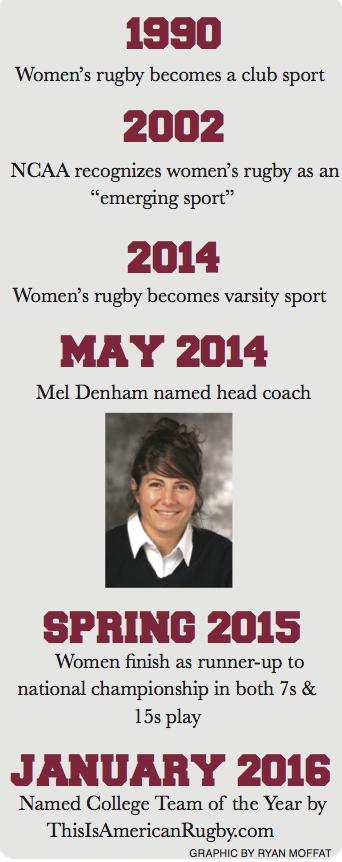Women’s rugby rise
February 9, 2016
Part two of our two week series chronicling the rise of Central’s rugby program. Part one can be read here.

When women’s rugby became a varsity sport, its success may have been an afterthought to what the men were projected to accomplish.
The program never had the history of dominance or the nationally televised championship tournament games the men’s team had.
They never even had the solid coaching foundation the men’s team had.
“They were a lot like many of our other sports clubs,” said Corey Sinclair, coordinator of collegiate sports clubs. “There was a student coach kind of serving in that role.”
The men’s team joined a league full of California teams to seek greater competition that would give them a real test. At the same time, the women were still content with playing regional matchups in the Northwest.
“Every competition they went to they were just driving,” Sinclair said. “They weren’t flying like the men were.”
According to Sinclair, the team was kind of “middle of the pack.”
“There were a few years there where we had hopes of making the playoffs,” Sinclair said.
But after becoming a varsity sport, the women finished runner-up for a national championship in both 7s and 15s play, losing both times to national powerhouse Penn State University.
To many, this showed that women’s sports shouldn’t just be an afterthought.
 “I think that’s great for women’s athletics…[they’re] still beating down the stereotypes,” Athletics Director Dennis Francois said. “But I think if [doubters] watch one rugby match, that changes their perception really quick.”
“I think that’s great for women’s athletics…[they’re] still beating down the stereotypes,” Athletics Director Dennis Francois said. “But I think if [doubters] watch one rugby match, that changes their perception really quick.”
That success could be partially attributed to the hiring of Mel Denham, a member of the USA Women’s Rugby National Team, as their head coach in May of 2014.
“We’re very excited about hiring her,” said Central Director of Rugby Tony Pacheco in a press release at the time of the hire. “We believe her coaching and playing experience will help us build the women’s program here into one that will become regionally and nationally prominent over the next several years.”
Denham’s hiring helped not only on the field, but also on the recruiting trail.
“She is one of the best coaches in the nation…and that’s a great selling point,” Francois said.
According to Sinclair, the $172,538 budgeted to the women’s team for the 2014-15 school year was much more than the team had as a club.
He said their budget as a club sport was probably only about 1 percent of that. While that wouldn’t pay much of the $56,784 salary Denham received last school year, the investment has proven beneficial so far.
Money aside, Denham was excited to take over as Central’s head coach.
“I think it’s really important for more programs to make this move” into intercollegiate athletics, Denham said in a press release after being hired. “I’m hoping the success of this [Central’s] program—as a varsity program—will inspire more teams to make the move.”
After the team’s run at a national title last year, they have been named college team of the year by ThisIsAmericanRugby.com in just their first year as a varsity sport.
“They are doing everything the guys do and sometimes better,” Francois said.
Central’s contract with the ‘Nike of Rugby,’ Serevi Rugby
Another perk of rugby’s elevation to varsity status came in the form of a partnership between Central and Serevi Rugby, the “Nike of Rugby.”
Serevi Rugby, now known as ATAVUS, is a partner of the U.S. Rugby Academy and helped train the Seattle Seahawks to tackle rugby style last season. Serevi officially partnered with Central on April 2, 2015.

According to Central Athletics, Central pays an annual service fee of $50,000, which is split into quarterly payments of $12,500. In addition, there is also a transportation rate of 60 cents per mile, which is based on actual mileage accrued.
In return, Serevi supplies recruitment support, off-field analysis of Central games and on-field coaching support in both the 15s and 7s programs.
“We couldn’t afford to pay those guys full-bore out of our pockets,” said Robert Ford, previous head coach of the rugby team and current senior director of alumni and constituent relations.
Support from Serevi is split into two portions: fall and spring.
The fall support lasts from September to December and mainly consists of consultation and planning. Spring support features more of the technical aspects of the game, such scrums, lineouts and fly half development, according to Central Athletics.
“It took us 13 years to build the program to where it is now,” Ford said. “I think it’s in tune with the rugby environment as well. The United States is starting to capitalize on the sport.”
Rugby squeezes space in Nicholson
By Evan Thompson, Contributing Writer
Though the decision to elevate Central’s rugby program to the varsity level may have seemed like a no-brainer, there were some issues in terms of facility space in Nicholson Pavilion.
Central’s Athletics Director Dennis Francois said that when Central hired the consulting firm Ice Miller LLP in 2012 to evaluate the state of its athletics department and collegiate sports clubs, the investigators concluded that the Wildcats’ limited facilities and amount of resources for sustaining surrounding programs were the main concerns.

Nicholson Pavilions indoor facilities are used by 13 different varsity teams.
The addition of the rugby program added around 90 new student-athletes, increasing the overall number of athletes to 440—a 25 percent increase.
With 13 athletic teams sharing the Pavilion’s gym and indoor facilities, Francois was aware the addition of rugby might detract from the experience of other athletes.
“I didn’t want [rugby] to negatively impact any of our current student-athletes and their experience,” Francois said. “There’s a few things that we aren’t going to be able to change in terms of making all of our athletic rooms bigger. We’ve got some facility challenges and [they] are probably exacerbated with the addition of rugby.”
Though most were pleased with the promotion of rugby to varsity, former Central rugby standout Patrick Blair felt a tad left out at first.
“When I heard about the news initially, I was bummed because I was graduating and wouldn’t get the satisfaction of playing as a varsity athlete,” Blair said in an email. “But that wore off rather quickly because I was beyond excited for the the program and my friends that got to be part of the varsity experience.”
